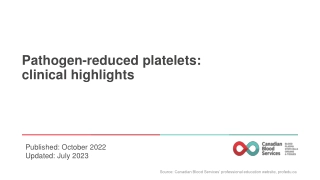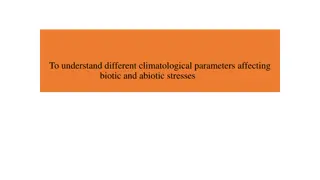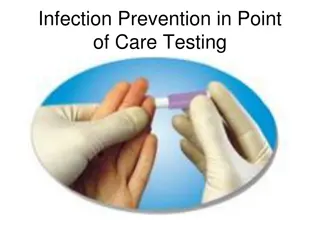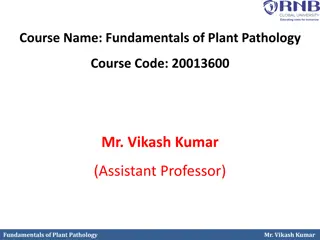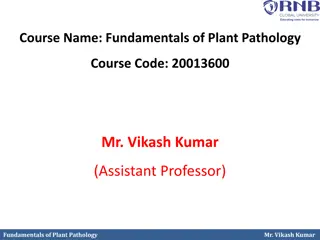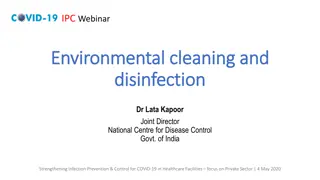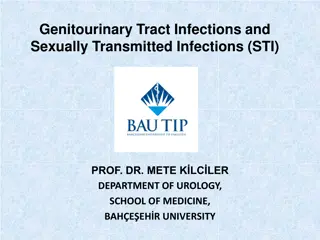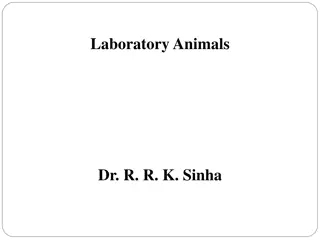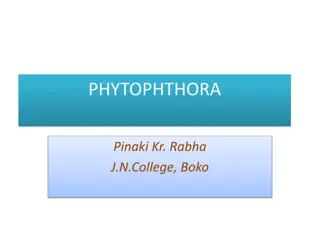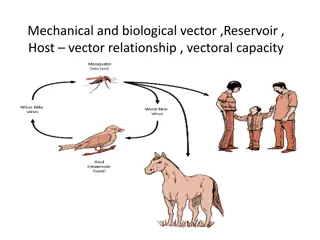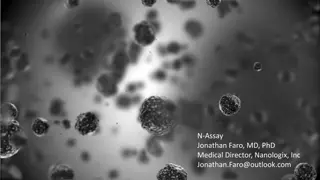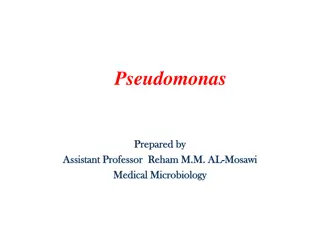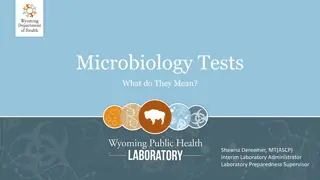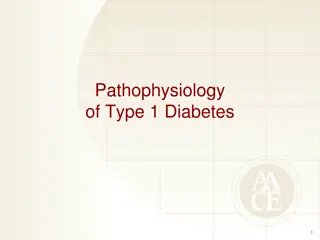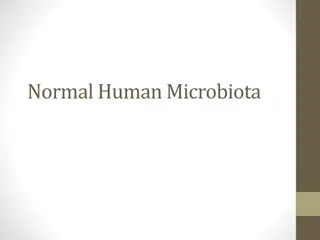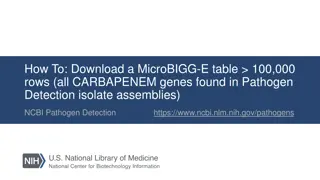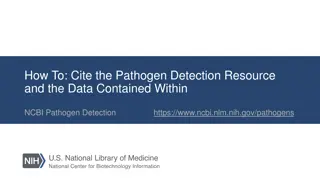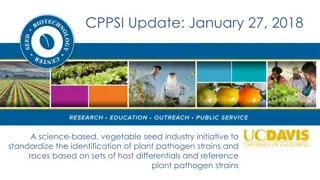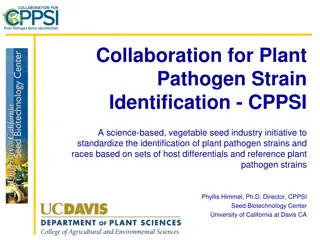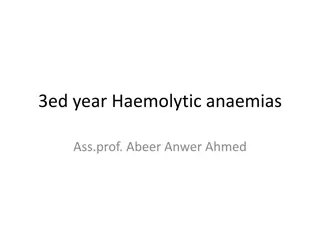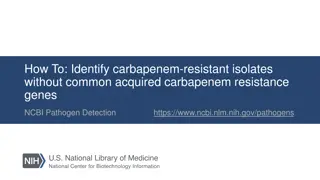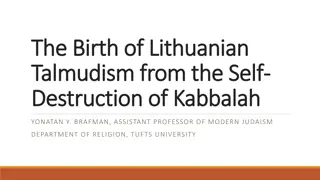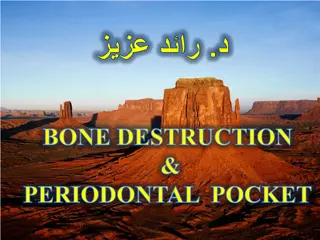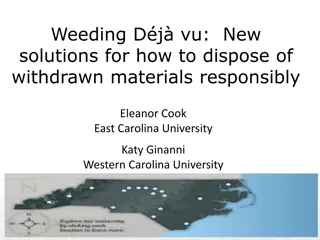Pathogen-reduced platelets: clinical highlights
Pathogen-reduced platelets play a crucial role in reducing the risk of transfusion-transmitted infections through pathogen inactivation technology (PIT). This technology provides an additional layer of safety against various pathogens including viruses, bacteria, protozoa, and leukocytes. Platelet c
2 views • 17 slides
A Scientific Approach to Pandemic Preparedness
Barney S. Graham, MD, PhD, outlines a scientific framework for epidemic and pandemic research preparedness to achieve fast and equitable access to high-quality vaccines for future pandemics. The discussion covers new human viral pathogens, 21st-century viral threats, viral taxonomy, and a prototype
0 views • 16 slides
Update on Pathogen Reduction of Platelets at National Haemovigilance Conference 2023
This update covers the latest developments in pathogen reduction of platelets, including the introduction of whole blood containing platelets. Key strategic initiatives focus on assessing post-collection blood product manipulation processes and developing new products to meet healthcare needs. The a
0 views • 25 slides
CANDIDIASIS
Candidiasis is an opportunistic fungal infection caused by Candida species. Learn about the pathogen, common infections, clinical settings, laboratory diagnosis, and treatment options associated with Candidiasis.
2 views • 33 slides
Understanding Impacts of Combined Stress Conditions on Plant Responses
Environmental stress factors like drought, heat, and pathogen infection can severely affect plant growth. Studies show that plants respond uniquely to combinations of stressors, with complex signaling pathways influencing their reactions. Field conditions differ from controlled lab settings, present
11 views • 5 slides
Antimicrobial Coatings Market: Exploring Sustainable Approaches to Microbial Con
The Antimicrobial Coatings Market is projected to reach $12.41 billion by 2031, at a CAGR of 10.8% from 2024 to 2031. The antimicrobial coatings help to keep surfaces pathogen-free by obstructing the growth of fungi, bacteria, and other parasites. Antimicrobial coatings provide long-lasting protecti
3 views • 4 slides
Understanding Hydroponics: Methods, Advantages, and Crops
Hydroponics, derived from Greek words meaning "working water," is a soilless plant-growing method. It offers various advantages like efficient water use, pesticide-free produce, and higher yields. Different types of hydroponic systems exist, enabling the cultivation of a wide range of crops. However
1 views • 15 slides
Infection Prevention in Point of Care Testing: Equipment and Hygiene Guidelines
This information focuses on infection prevention measures related to point-of-care testing (POCT), particularly concerning shared devices like lancing equipment and glucometers. It highlights the importance of evaluating equipment design, proper hand hygiene practices, and guidelines for using finge
0 views • 9 slides
Understanding Fundamentals of Plant Pathology with Mr. Vikash Kumar
Dive into the world of plant pathology with Mr. Vikash Kumar, an Assistant Professor, as he covers the course objectives, introduction to plant diseases, definitions, scope, responsibilities, and the importance of plant diseases. Learn about identifying diseases, pathogen nature, disease management
0 views • 10 slides
Fundamentals of Plant Pathology with Mr. Vikash Kumar - Course Overview and Important Pathogens
This course with Mr. Vikash Kumar covers the fundamentals of plant pathology, including identification of diseases, pathogen nature, disease management strategies, and principles. Learn about important plant pathogenic organisms such as fungi, bacteria, and fastidious vascular bacteria, along with s
0 views • 12 slides
Best Practices for Environmental Cleaning and Disinfection in Healthcare Settings
Effective environmental cleaning and disinfection are crucial in reducing healthcare-associated infections, especially in the context of COVID-19. This webinar by Dr. Lata Kapoor emphasizes the importance of cleaning high-touch surfaces and implementing established cleaning strategies to remove biob
0 views • 18 slides
Overview of Genitourinary Tract Infections and STIs by Prof. Dr. Mete Kılcıler
Genitourinary Tract Infections and Sexually Transmitted Infections (STIs) are common conditions affecting both men and women. This article, presented by Prof. Dr. Mete Kılcıler from the Department of Urology at Bahçeşehir University School of Medicine, delves into the various aspects of UTIs, in
2 views • 47 slides
Understanding Laboratory Animals and Their Classification
Laboratory animals play a crucial role in scientific research due to their physiological similarity to humans. Common types include mice, rats, hamsters, guinea pigs, rabbits, and monkeys. They are classified into conventional and gnotobiotic animals based on their microbial status. Specific pathoge
1 views • 67 slides
Understanding Phytophthora: Destructive Plant Pathogen
Phytophthora is a destructive plant pathogen that infects various crops, causing symptoms like leaf lesions and rotting tubers. Its somatic structure includes profusely branched hyphae, and it reproduces asexually through zoospores. The germination process involves the spread of spores by wind and w
1 views • 21 slides
Vector Relationships and Pathogen Transmission
Understanding mechanical and biological vectors, reservoir hosts, and their role in disease transmission is crucial for effective disease control. Mechanical vectors like flies can transfer pathogens without getting infected, while biological vectors like mosquitoes carry pathogens that reproduce in
1 views • 5 slides
Revolutionary N-Assay: Transforming Pathogen Detection in Healthcare
Innovative N-Assay developed by Jonathan Faro, MD, PhD, offers a faster, more accurate, and cost-effective solution for detecting bacterial pathogens in healthcare settings. Unlike traditional assays, N-Assay differentiates between viable and non-viable pathogens, provides information on antibiotic
1 views • 15 slides
Overview of Laboratory Animals and Their Uses in Biomedical Research
Laboratory animals play a crucial role in biomedical research, serving as models for studying various conditions affecting humans and animals. They must thrive in controlled conditions and are used to test hypotheses and drugs. Commonly used lab animals include rodents, lagomorphs, canines, felines,
0 views • 9 slides
Overview of Pseudomonas aeruginosa: Morphology, Identification, and Lab Diagnosis
Pseudomonas aeruginosa is a gram-negative, motile bacterium commonly found in soil, water, plants, and animals. It is a major pathogen known for causing infections in individuals with weakened immune systems. This article delves into the morphology, identification techniques, and lab diagnosis metho
0 views • 7 slides
Understanding Microbiology Testing Methods and Results
Explore the various methods of microbiology testing, learn to interpret microbiological test results, and understand antibiotic susceptibility testing. Discover details on bacterial, viral, and parasitic infections through laboratory reports and supporting results like WBC counts and pathogen identi
0 views • 29 slides
Understanding Salmonella: A Zoonotic Pathogen
Salmonella, a genus of bacteria, includes species causing various diseases in humans, cattle, sheep, goats, and poultry. The pathogen can be transmitted through contaminated food and is classified into typhoidal and nontyphoidal serovars. Nontyphoidal serovars are common and typically lead to self-l
0 views • 20 slides
Understanding Host Defense Mechanisms Against Infection
Host defense mechanisms safeguard the body from pathogens through various strategies such as intact skin, mucous membranes, nonspecific immune responses like phagocytic cells, and specific immune responses involving antibodies and lymphocytes. Key protective barriers include the skin, eyes, digestiv
3 views • 16 slides
Understanding Type 1 Diabetes Pathophysiology and Etiology
Type 1 diabetes is characterized by absolute insulin deficiency, resulting from pancreatic beta cell destruction. It is prone to ketosis with a total deficit of circulating insulin, often due to autoimmune factors. The pathophysiology involves inflammation, immune-mediated cell destruction, and a ch
0 views • 13 slides
Understanding Normal Human Microbiota and Its Role in Health
Normal human microbiota refers to the microorganisms residing on our skin and mucous membranes, playing vital roles in digestion, immunity, and protection against pathogens. They are categorized into resident and transient groups, with resident flora aiding in maintaining health by synthesizing nutr
0 views • 28 slides
Understanding Host-Parasite Relationship in Microbiology
In microbiology, the host-parasite relationship is crucial for understanding diseases caused by pathogens. This lecture covers definitions of terms like pathogenicity, pathogen, disease, resistance, susceptibility, infection, virulence, and transmissibility. It also delves into the division of host
0 views • 16 slides
Physics Experts Unravel Crime Mystery Involving Historic Vase Destruction
Physics experts join forces with the police to investigate the destruction of a priceless historic vase. By analyzing clues such as security camera footage, car acceleration data, and balcony heights, they aim to uncover the identity of the culprit responsible for this egregious act in the early hou
0 views • 12 slides
How to Download a MicroBIGG-E Table with >100,000 Rows from NCBI Pathogen Detection
Learn how to download a MicroBIGG-E table containing all CARBAPENEM genes found in Pathogen Detection isolate assemblies on NCBI. Follow a step-by-step guide to select, filter, and download subsets of data in batches to get the complete dataset.
0 views • 10 slides
How to Cite NCBI Pathogen Detection Resource
Learn how to correctly cite the Pathogen Detection Resource and data within NCBI Pathogen Detection. Follow guidelines on citing the entire resource, subsets of data, accessing Isolates Browser & MicroBIGG-E, using NCBI AMR resources, and acknowledging data submitters in your manuscript.
0 views • 8 slides
Love vs. Selfishness: Lessons Learned from Jerusalem's Destruction
The destruction of Jerusalem in 70 AD serves as a poignant reminder of the consequences of rejecting God's love and succumbing to selfishness. Through historical accounts and biblical references, we uncover the tragic events leading to Jerusalem's downfall, emphasizing the importance of fidelity, co
0 views • 12 slides
Understanding Plant Pathology: Reproduction and Classification of Bacteria
This course on Fundamentals of Plant Pathology, led by Mr. Vikash Kumar, covers essential topics such as disease identification, pathogen nature, disease management strategies, pathogen classification, and plant disease diagnosis. It delves into the reproduction and classification of plant pathogeni
0 views • 16 slides
Standardizing Identification of Plant Pathogen Strains in Vegetable Seed Industry
Focused on standardizing plant pathogen strain identification, the CPPSI initiative by UC Davis works towards enhancing the industry's capabilities. Through reference materials and strategic collaborations, CPPSI aims to streamline disease management processes and promote sustainability. The project
0 views • 8 slides
Collaboration for Plant Pathogen Strain Identification - CPPSI Initiative Overview
CPPSI, a science-based initiative in the vegetable seed industry, aims to standardize plant pathogen strain identification using host differentials and reference strains. The goals include developing differential host sets, enhancing awareness, and facilitating material distribution. Criteria for ex
0 views • 12 slides
The Tragic Tale of Jezebel: Queen of Idolatry and Destruction
Jezebel, the infamous queen from the Bible, led her husband and the nation of Israel astray with her worship of false gods like Baal and Ashtoreth. Her corrupt practices and influence ultimately led to wickedness, the persecution of God's followers, and a legacy of destruction. Despite her power, Je
0 views • 6 slides
Sustainable Refrigerant Management: Local Destruction & Montreal Protocol Strengthening
Explore the significance of affordable local destruction of ozone-depleting substances (ODSs) and HFCs for life cycle refrigerant management. Learn about the importance of strengthening the Montreal Protocol to mitigate climate impacts. Discover key takeaways for preventing climate tipping points, p
0 views • 17 slides
Role of Lipids in Plant-Pathogen Interaction
Lipids play a central role in signal molecule production for actively modifying the invasive capabilities of pathogens and the defensive mechanisms of plants during inter and intra-plant-pathogen interactions. They are essential constituents of membranes, providing structural support and serving div
0 views • 43 slides
Understanding Haemolytic Anaemias: Causes and Classification
Haemolytic anaemias result from increased red cell destruction, involving normal red cell breakdown processes like extravascular removal by macrophages. This breakdown leads to the liberation of iron, bilirubin circulation, and protein synthesis. An introduction to haemolytic anaemias explains how t
0 views • 27 slides
Nebuchadnezzar's Dream and Lessons Learned from Daniel 4
Nebuchadnezzar's dream of a tree in the midst of the earth, its destruction, and the subsequent lessons learned about humility, the insignificance of mankind in front of God, and the importance of praising the Most High. The story highlights how reality humbles and can lead to destruction if one wal
0 views • 8 slides
Comprehensive Guide to Identifying Carbapenem-Resistant Isolates Without Common Acquired Carbapenem Resistance Genes
Utilize the Isolates Browser on NCBI Pathogen Detection platform to search for carbapenem-resistant isolates without common acquired resistance genes. Follow steps such as using AST phenotypes and AMR genotypes, cross-browser selection, and filters to isolate relevant results. Detailed instructions
0 views • 6 slides
The Birth of Lithuanian Talmudism: Destruction of Kabbalah
Birth of Lithuanian Talmudism from self-destruction of Kabbalah explored by Yonatan Y. Brafman, highlighting the impact of conceptualizing Halakhah on modern Judaism. The discourse of modernity and Jewish law's role in continuity or discontinuity are examined through an overview setting the stage fo
0 views • 23 slides
Understanding Bone Destruction in Periodontal Disease
The progression of periodontal disease can lead to bone destruction in the alveolar bone, which is crucial in supporting teeth. The inflammatory process causes permanent damage to the periodontium tissues, resulting in connective tissue loss and bone resorption. Different patterns of bone loss, such
0 views • 14 slides
Responsible Disposal Solutions for Withdrawn Materials
Explore new, eco-friendly solutions for responsibly disposing of withdrawn materials in libraries, including options like local book sales, campus surplus sales, transfer to other agencies, and working with vendors. Discover the importance of being green and utilizing records destruction companies o
0 views • 13 slides
